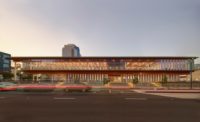MIT Hayden Memorial Library by Kennedy & Violich Architecture
Cambridge, Massachusetts

Hayden Library at MIT. Photo © John Horner
Architects & Firms
The most surprising part of visiting the Charles Hayden Memorial Library at Massachusetts Institute of Technology (MIT) in Cambridge, Massachusetts, is going inside. From the exterior, the stalwart modern structure, clad in limestone, looks much as it has since it opened in 1951. Now, when you enter, you find that the place has been radically altered so that space and light permeate the interior—vertically through stairs pushing up into an atrium-like opening, and horizontally with a glazed inner courtyard on one side and expanses of bay windows on the other. The renovation, by Boston-based Kennedy & Violich Architecture (KVA), has thoroughly transformed “a book barn without charm,” as Sheila Kennedy, KVA principal and MIT architecture professor, describes the original incarnation.
Hayden Library occupies one side of the square-donut-shaped Building 14—which also houses a music library, exhibition gallery, small music hall, and classrooms that were not in the purview of this renovation—and is in the prime location for this block: it faces south, to the tree-lined Memorial Drive and the Charles River beyond. The building was designed by Voorhees, Walker, Foley & Smith, whose principal, Ralph Walker, an MIT architecture graduate (1911), achieved acclaim for his New York Art Deco skyscrapers of the 1920s and 1930s. But his later Hayden Library was more perfunctory.

1
The first floor, once dreary (1), is transformed (2). Photos courtesy MIT (1), © John Horner (2), click to enlarge.
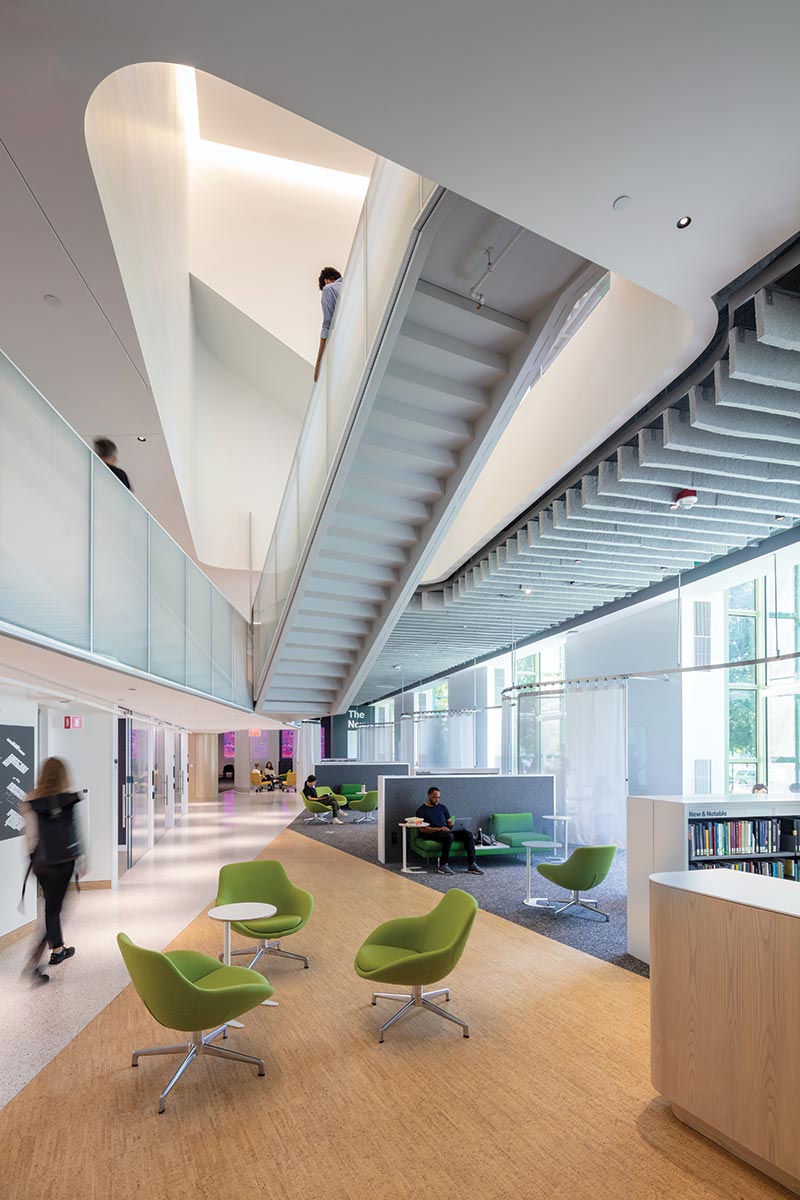
2
The most outstanding feature of the two-story building is the row of rectilinear bay windows facing the Charles, which rise elegantly to 36 feet. The straightforward interior, however, had turned drab and gloomy with age. On top of that, Hayden had to be brought in line with contemporary codes for HVAC, accessibility, and sustainability. (The newly renovated LEED Gold library also meets the Living Building Challenge and Fitwel criteria for a healthy environment, including non-toxic materials.)
Additionally, MIT had to consider the library’s role in student life, particularly in the digital age, which has rendered books less important. “We wanted to emphasize connection and community,” says Chris Bourg, MIT’s director of libraries. In selecting an architect the client looked for a firm that would address the library’s desire for scholarship as well as socializing—an activity once considered antithetical for this building type. “Libraries have to evolve,” notes KVA principal, J. Frano Violich. “You still need to do research, but also have places to talk.” KVA’s scope of work involved three components: first, redoing the bar-shaped, 45,000-square-foot volume reserved for the library; the second piece of the puzzle was redesigning the building’s interior courtyard; and the third was adding a “porch” along the east side of the courtyard, next to Building 14’s Lewis Music Library (where the firm also remodeled the second floor’s East Study Room).
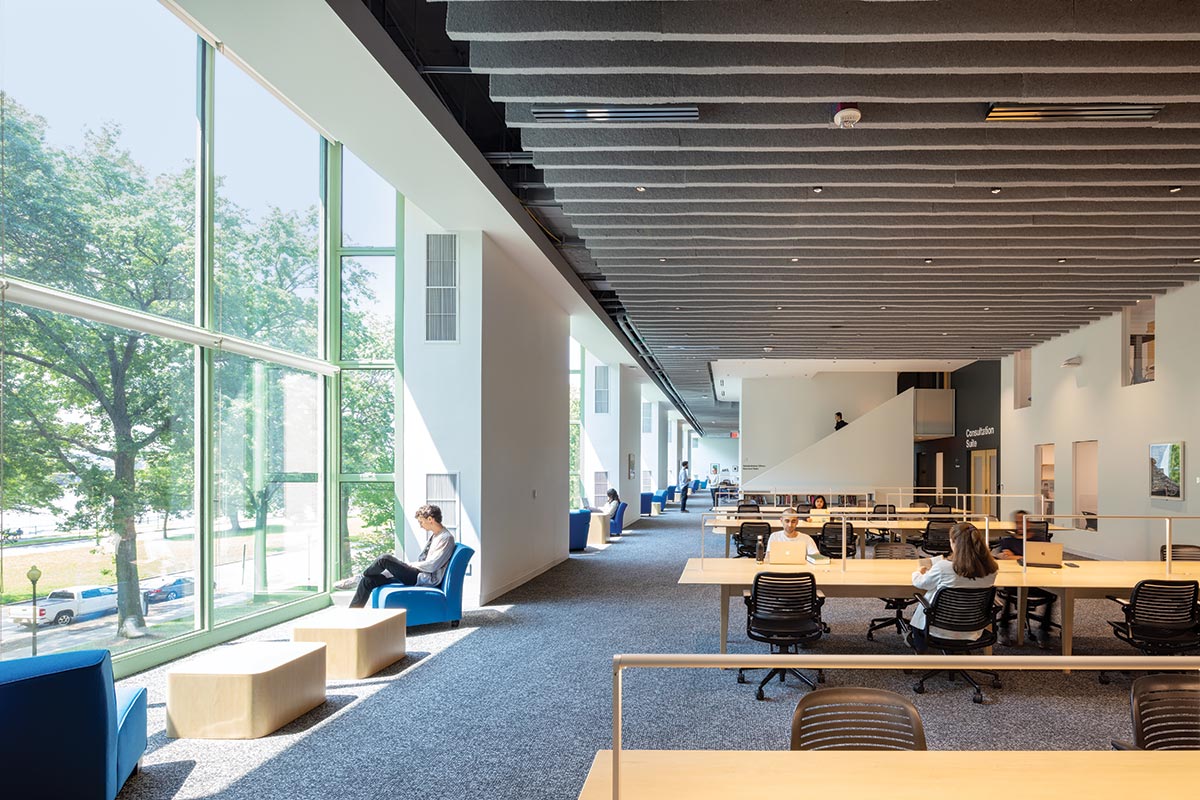
The reading room on the second floor (above) has views of the Charles River. Photo © John Horner
The programmatic concept of the library itself is quite logical: most of the collection of 300,000 books, and related materials devoted to science and the humanities, are squeezed into compact storage systems in the basement, which extends under the courtyard. A second-floor reading room is reserved for quiet study. A café on the main floor along the courtyard welcomes both the academic community and the public, and the rest of the ground floor, which faces Memorial Drive, is open 24/7 for study or gathering.

The facade on Memorial Drive had single-paned glass in 1951 (above), but now is double-glazed (top). Photo courtesy MIT
Hayden’s street-facing facade presented some complicated calibrations: drafty single-pane windows needed to be replaced with double-paned insulated glass. These thicker units meant recreating new customized sashes in the projecting bays and end window walls, and presented the added challenge of removing the existing framing “without messing up the limestone,” says Joyand Charles, MIT’s project manager for campus construction.
Inside, the tricky part of the design was how to give the spaces a sense of fluidity, light, and views out while providing vertical circulation, and tucking in small study areas, conference rooms, and staff offices on each level. KVA inserted the stair to the main reading room by removing some steel beams and carving out a curvilinear opening in the floor’s concrete deck, then angling and cantilevering the stepped runs through the curved void. Light emanates from above, dramatically enhancing this dynamic interplay.

3

4
The stairs on the first floor rise past the double-level pavilion and its small-group study rooms (3), then angles up to the second floor’s main reading room (4). Photo © John Horner
Two pavilions inserted within the 19-foot-high main floor separate the café from the open library area and contain group study rooms and other functions. One is clad in transparent and translucent glass, the other in ash wood, and both pavilions have mezzanines, including a small balcony-like “nest” for small gatherings. To give the first-floor seating areas an added sense of enclosure, KVA designed translucent fabric “curtain walls” that weave sinuously through the room. On the voluminous second floor, the quiet reading room looks out to Memorial Drive, while behind it is the “Oasis” dominated by upholstered chairs for relaxation, as well as offices and conference rooms.

Throughout, felt ceiling baffles, white ash paneling, and cork floors define the areas. Photo © John Horner
In order to solve acoustical problems in this open, upwardly flowing space, the architects installed baffled ceilings of gray felt made from recycled clothing, which became a strong textural motif throughout. (Other materials with acoustical properties include cork on walls and floors, felt backing for freestanding bookcases, and, of course, carpeting.) Where the original dropped ceilings caused a sense of claustrophobia, you now can gaze up through the baffles, giving you a sense of vertical expansion.
KVA worked with Stephen Stimson Landscape Architects for the second part of the project: redesigning the interior courtyard. To encourage more abundant planting, the team raised the previously depressed courtyard 4 feet (and, in some places higher, through berms and mounds). Within this garden, the designers introduced curvilinear seating and added Katsura trees to soften the overall effect.
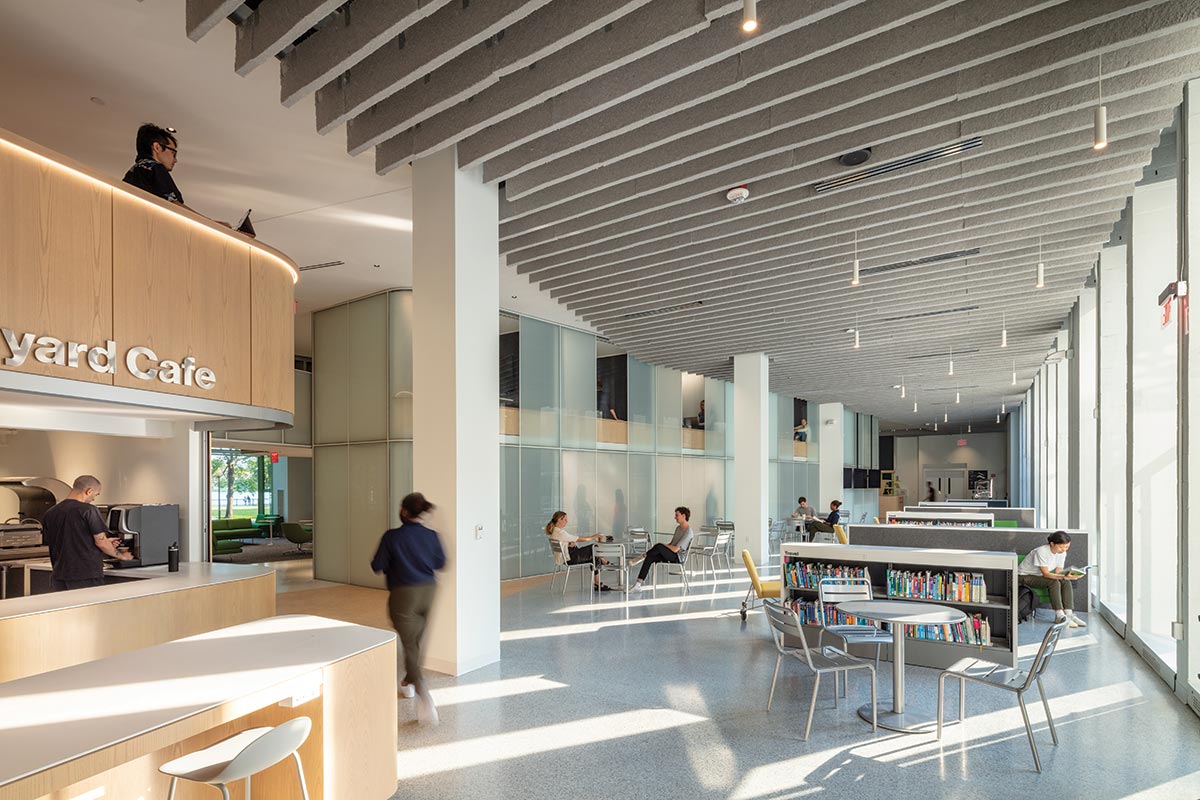
The café opens to the inner courtyard. Photo © John Horner
For the project’s third component, the architects created a courtyard-facing “porch” along the east side of Building 14. Students now congregate in this seating area, which can be enclosed by folding glass doors in the cold months. The linear space also forms a protected circulation path that continues around the other sides of the courtyard. The porch’s ash plywood ceiling demonstrates another KVA specialty: the architects fabricated the CNC-milled panels in their office shop. The surface is dominated by an amoeba-like abstract pattern, a distinctive design motif that appears throughout the interior and is repeated in punctured openings of the horizontal steel brise-soleil jutting out from the porch. Once again, the forms show up in the dappled sunlight hitting the terrazzo floor.
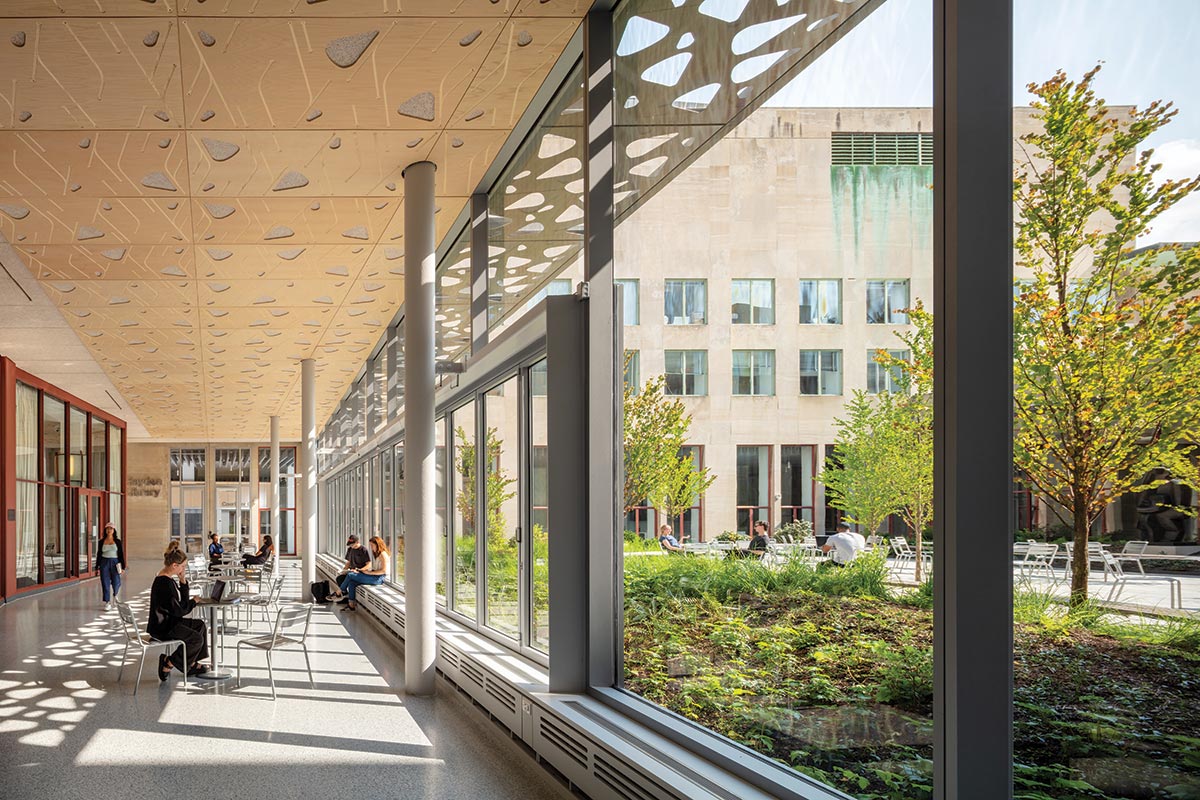
KVA designed a porchlike sitting area on an adjoining side of the courtyard, including its milled-wood ceiling. Photo © John Horner
Whereas the older building represented one approach to modern architecture in its stately, rectilinear treatment, the renovation boldly plays with voids, curvilinear and diagonal elements, and different materials. And as you walk through the various parts of the library—inside and out—you are struck by the way spaces dramatically open up, yet cozy niche-like areas still abound. Daylight is constantly a lambent presence, and the view of the Charles River can always soothe the studious mind.
Kennedy & Violich Architecture (KVA) founding principal Sheila Kennedy is a featured speaker at the forthcoming Boston edition of Record on the Road, entitled "Sustainability in Practice." The event will be held June 20 at MIT's Samberg Conference Center.Click plans to enlarge

Credits
Architect:
Kennedy & Violich Architecture
10 Farnham Street
Boston, MA 02119
617 442 0800
www.kvarch.net
Personnel in architect's firm who should receive special credit:
Sheila Kennedy FAIA – Design Principal, Frano Violich FAIA - Managing Principal, Ned Goodell AIA – Project Architect, Ben Widger AIA, Daniel Sebaldt AIA, Nick Johnson, Hannah Liechty, Danniely Staback Rodriguez, Kevin Marblestone, Toshiki Niimi, Lynced Torres, Greta Wong, Jess Jorge, Chris Weaver, Mark Bavoso, Daniel Marshall, Clarence Lee, Julian Geltman
Architect of record:
Kennedy & Violich Architecture
10 Farnham Street
Boston, MA 02119
617 442 0800
www.kvarch.net
Engineers
Structural Engineer: Buro Happold
MEPFP Engineer: Buro Happold
Building Envelope: Simpson Gumpertz & Heger
Consultants:
Landscape: Stephen Stimson Associates
Code/Accessibility: Jensen Hughes
Sustainability: Thornton Tomasetti
Lighting Design: Buro Happold
Acoustics: Cavanaugh Tocci Associates
Audiovisual Design: Communications Design Associates
Cost Estimation: Vermeulens
Civil Engineering: Haley & Aldrich Inc
General contractor:
Elaine Construction Company, Inc.
Photographer:
John Horner Photography
Specifications
Structural System:
Structural Steel - Library Pavilions and Stairs: Ryan Iron Works
Structural Steel - Courtyard Pavilion Frame: Boston Steel Fabricators
Exterior Cladding:
Masonry: Metropolitan Masonry, Waterproofing and Restoration, Inc.
Precast concrete: Northern Design Precast
Moisture barrier: GCP Perm-A-Barrier
Aluminum Curtain wall - Pavilion: Kawneer 1600 SSG
Accordion Storefront – Pavilion: Nanawall
Roofing:
Elastomeric: Carlisle Sure-Seal EPDM
Courtyard Below Grade Waterproofing: GCP Permabarrier
Air Vapor Barriers: Carlisle VapAir Seal
Windows:
Custom steel frame glass bay storefront: A&A Window
Motorized window shades: MechoShade EcoVeil
Glazing:
Interior Curved Glass: Standard Bent Glass
Exterior IGUs: Vitro Architectural Glass Solarban 72 on Starphire
Doors:
Pavilion Entrances: Kawneer 350 Heavy Door
Fire rated stair door: Total Door Systems
Sliding glass doors: CR Laurence
Aluminum Security Screens: Cascade Coil Drapery, Inc.
Accordion Overhead Door: Skyfold Classic 51
Interior Wood Doors: Eggers, Ind.
Interior Metal Doors: De La Fontaine Industries
Hardware:
Locksets: Schlage
Closers: LCN
Exit devices: Von Duprin
Pulls: Ives
Security devices: Schlage
Ceiling Pipe Grid: Cheviot Corporation, SSRC
Acoustical Ceiling Hangers: Kinetics Noise Control
Interior Finishes:
Acoustical felt baffle ceilings: Cheviot Corporation, Acoustical Surfaces, Inc. Echo Eliminator
Suspension grid: Armstrong
Cabinetry and custom woodwork - Library: Watson Brothers LLC
Custom woodwork – Pavilion: Windsor Woodworking
CNC custom wood ceilings - Pavilion: Kennedy & Violich Architecture
Paints and stains: Benjamin Moore
Felt wall coverings: Filzfelt
White Ash Wood Paneling: Watson Brothers LLC
Plastic laminate: Wilsonart
Solid surfacing: Corian
Cork floors: Duro Design – Edipo
Terrazzo floors: DiPaoli Mosaic
Floor and wall tile: Daltile
Resilient flooring: Nora Commercial Flooring
Carpet: Mohawk Group
Furnishings:
Office furniture: Herman Miller
Reception furniture: OFS
Fixed seating: OFS
Chairs: Herman Miller
Tables: Herman Miller
Café Stools: Allermuir
Upholstery: Maharam
Courtyard and Café Furniture: Juniper House
Lighting:
Interior ambient lighting:
Downlights: USAI Lighting,
Recessed Linear Downlights: Mark Architectural Lighting
Curved Cove Light: iGuzzini
Downlight Pendant Cans: ALW, Lumenwerx
Theatrical Lighting: Illuminate
Dimming system or other lighting controls: Lutron
Conveyance:
Elevators: Otis Elevator Company
Plumbing:
Toilets and Flush Valve: Toto
Lavatories: Toto, Kohler
Kitchen Sinks: Elkay
Scullery Sinks: John Boos
Faucets: Toto, Chicago Faucets
Drinking Fountains: Halsey Taylor
Café Kitchen Equipment: Johnson-Lancaster and Associates, Inc.


